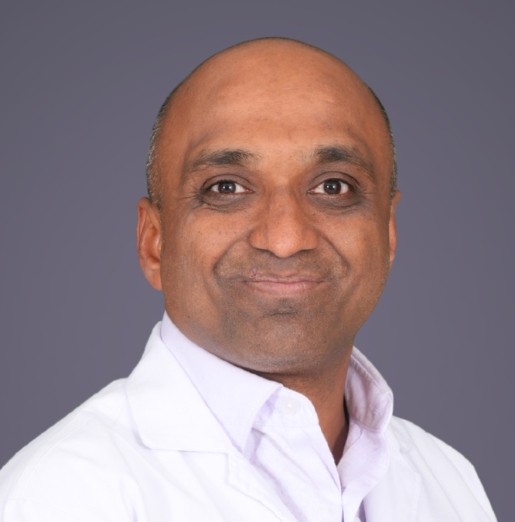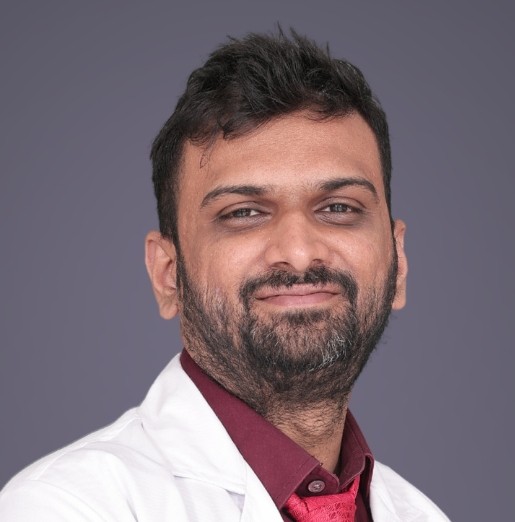The Bone Marrow Transplant (BMT) and Cellular Therapy Department at KIMS Hospitals in Mahadevapura aims to deliver top-notch patient care while focusing on education and research.
The team working in the BMT department values empathy, integrity, confidentiality, collaboration and innovation. They prioritize taking initiative in their work. Our team of highly experienced professionals is here to guide you through every step of the process, ensuring you receive the best possible care.
What is a stem cell?
Hematopoietic Stem cells (HSC) are unique cells found in the bone marrow of our body. HSCs through their ability to self-renew and to differentiate, are responsible for the continuous production of mature blood cells throughout life. These young stem cells have the potential to grow into any kind of blood cell.
Any illness or condition that stops your bone marrow from creating healthy blood cells can lead to serious complications. Stem cell transplants can work well as a treatment to address these kinds of problems and are curative in most of the conditions.
What are the Two Types of Stem Cell Transplants?
The following are the two main types of stem cell transplants:
Autologous Stem Cell Transplant
In an Autologous stem cell transplant, doctors collect the patient's own healthy stem cells through apheresis and many times store them.
This method is used to treat illnesses such as:
- Multiple myeloma
- Lymphomas - Relapsed Hodgkins and Non-Hodgkins Lymphomas
- Recurrent Germ cell tumors
- High grade brain tumors in children
- Recurrent Ewing's sarcoma
- High risk Neuroblastoma
- Multiple sclerosis and many other diseases
The process:
1. Autologous Stem Cell Collection: Stem cells are collected from patients own blood through a process called Apheresis. This is generally done after a mobilizing stem cell with Growth factors which helps draw the stem cells from bone marrow into patients’ bloodstream.
2. Conditioning Regimen: Patients will receive chemotherapy and/or radiation therapy to eliminate cancer cells and make room for the new healthy stem cells. This will lead to complete or partial elimination of stem cells from the bone marrow.
3. Stem cell Transplantation: The collected stem cells are infused back into the patient's blood intravenously, like a blood transfusion. The healthy stem cells migrate to the bone marrow and begin to produce new blood cells and help in recovering healthy hematopoiesis.
Since the patient's own cells are used, the risk of rejection or graft-versus-host disease (GVHD) is very low, or graft rejections are very low.
Allogeneic Stem Cell Transplant
In an allogeneic transplant, hematopoietic stem cells are obtained from a compatible donor (related or unrelated).
Indications of Allogeneic HSCT includes:
A. Malignant disorders
- High risk / Relapsed B cell Acute lymphoblastic leukemia/Lymphoma
- High risk / Relapsed T cell Acute lymphoblastic leukemia/Lymphoma
- Mixed phenotypic acute leukemia
- High risk / Relapsed Acute myeloid leukemia
- Juvenile myelomonocytic leukemia
- Myelodysplastic syndrome
B. Non-Malignant Conditions
- Transfusion dependent Thalassemia major
- Sickle cell anemia
- Severe aplastic anemia
- Congenital bone marrow failure syndromes like Fanconi anemia, Dyskeratosis congenita
- Primary immunodeficiency disorders like Severe Combined Immunodeficiency
- Lysosomal storage disorders like Mucopolysaccharidosis, Gaucher’s disease, Niemann Pick disease.
There are many other conditions where Allogeneic HSCT is curable. The process includes:
1. Finding a suitable Donor
This is the foremost and most important step for allogeneic HSCT. This is done by doing a special test called High resolution Human leucocyte antigen (HLA) typing of patients and relatives. Matched sibling donors are considered best and are available in 25-30% of cases. Parents are HLA half matched in most of the patients and with the latest techniques, it’s feasible to do HSCT using half matched donors.
2. Preparing Patient and Donor for HSCT
It is important to prepare patients and donors for allogeneic HSCT. For patients, adequate control of disease, nutrition status, psychological, cardiac, pulmonary status evaluation and optimizing their performance status plays a major role in the success of HSCT. Donors are routinely screened for any major health issues and are given nutritional supplements before stem cell donation. In some diseases patients receive pre transplant treatment to prepare them well for HSCT.
3. Admission to BMT and Conditioning Regimen
After admission to BMT unit a central line - either a Hickman Catheter or Central venous line or PICC line (Peripherally inserted central catheter) is placed depending on the clinical requirement. Followed by a conditioning regimen to clear the marrow of disease - this includes Chemotherapy medicines, Immuno therapy / Radiation.
4. Stem Cell Collection: The donors stem cells can be collected by 2 methods
Peripheral blood stem cell collection via Apheresis machine = can be done on day care basis in Procedure room. It is a simple procedure, and the donor can be discharged on the same day.
Bone marrow Harvesting - In this procedure, bone marrow is collected from posterior superior iliac spines and crest (Hip bones) under general anesthesia in Operation theater.
5. Stem Cell Transplantation: The donor's stem cells are given to patients intravenously like any other blood transfusion. This treatment calls for a hospital admission for 3-4 weeks, close observation and safety protocols because the patient's immune system is weak. Doctors use allogeneic bone marrow or stem cell transplants to treat blood cancers like leukaemia that affect the bone marrow. Donor stem cells, which match the patient's tissue, are used in this process.
After the patient undergoes chemotherapy and sometimes full-body radiation, the donor cells are infused. These transplants not only restore the body's ability to make blood but also target cancer. The donor cells create a new immune response that destroys cancer cells, often more than the patient's original immune system. This process, called the graft-versus-cancer effect, helps attack cancer in the body. Using allogeneic stem cells increases the chances of rejection or graft-versus-host disease.
When you get stem cells from a donor, your immune system might respond by triggering graft-versus-host disease, or GVHD. The donor's immune cells may attack your body, mistaking it for a threat. GVHD can harm areas like your skin, liver, or Gastrointestinal system and might show up as symptoms like rashes, stomach pain, loose stools or yellowish discoloration of skin. Doctors often use medicines to control the immune system and ease these problems.








